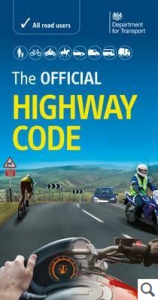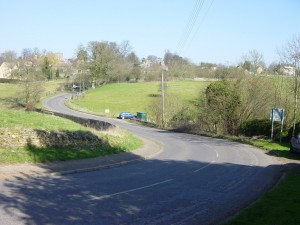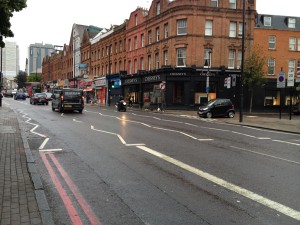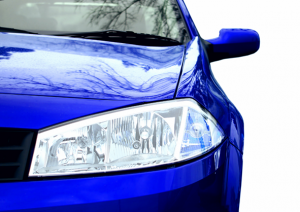This area of the Wolverhampton Advanced Motorists web site is focussed on the needs and support of Associates. If you are an Associate then any thoughts you have about information you would like to have here would be most welcome. Just let us know by sending an e-mail to the Web Admin by clicking here.
WAM is not an overly formal group however we do have some expectations of our Associates in order to ensure the best possible outcome from your endeavours to become a safer advanced driver.
Group Expectations of Associates
- Please attend the Associate Evenings that we run, these are detailed on the Group Events Diary page of this web site and take place most months.
- Please work closely with your Observer and undertake regular drives with that Observer.
- Please do your best to attend the monthly Group Meetings as these will give you opportunity to meet other Associates and also other Members of the Group as well as having opportunity to discuss matters which may be troubling you regarding advanced driving.
- Please read through the book that you have been sent by IAM RoadSmart. This contains a great deal of useful and important information. You do not need to read through every page but please do read through those areas where “approach and technique” are perhaps different to that which you have been using to date. (It is a guide and not a litany; use it to raise questions and improve understanding through discussion with your Observer).
- Do not feel that at any time you are alone, the Group exists to support your development; if you have questions about anything to do with advanced driving then raise them, if not with your Observer then use the Contact-us page on the web site or talk to someone at one of our many meetings.
- Please use the web site, this provides a wealth of information and support materials for your use. Visit the Group Events Diary regularly and if you can subscribe to the Facebook and Twitter feeds so that you are kept up to date about what is happening within the Group and around the Group. (The web site also provides a continuously updated feed from all local Emergency Services so is a great resource for your use prior to any journey).
- Please think about contributing to the Group, your support is essential for our continuance, you would be welcome, (even as an Associate), on the Committee, your support at Events would be undoubtedly appreciated and your contributions to the News Letter and the content of the web would be welcomed.
Important and Useful Information for All Drivers
Please take a look at the following page; this contains a wealth of information that may help improve your general driving; this News Section is worthy of your continued visits as we are trying to place a new item at least every week. This is a resource for your use, please use it.
Wolverhampton Group General Structure
In keeping with the majority of the two hundred groups around the country WAM is organized as follows:

The Group Committee meets on a monthly basis to ensure the smooth running and management of the Group and the various activities that it is engaged in including the planning of forthcoming events. As a registered Charity we are obliged to have a Chairman, a Secretary and a Treasurer however there are many other “jobs” that require attention and support including Events Management, Associate Management, Observer Management and so on. There are always things that need to be done so if you feel that you could provide support then please visit the Events Diary Page of this web-site and attend the next Committee Meeting, be assured, you would be made most welcome.
The current Committee Members are as follows:

You can view these details on the Contact-us page of the web site by clicking here. This will allow you to e-mail any of the individuals directly should you want.
We encourage all Members of the Group including Associates to be active within the Group and help improve road safety in general so do keep visiting this site to keep up to date with what is going on and also consider supporting us if you feel that you can spare a little time every month.
Training Presentations for Associates
We provide Theory Lessons as well as practical Observed Drives to help you to get through your Advanced Drivers Test. The Presentations are given monthly in rotation and we encourage all Associates to do their very best to attend each of the two sessions. You can see full details of when and where they are being held by looking at our Group Events Diary which can be viewed by clicking here.
The presentations are available here for your revision:
Associate Presentation Part 1 January 2019 v3.2
Associate Presentation Part 2 January 2019 v3.5
The Highway Code
The Highway Code is being updated on a regular basis so it’s often difficult to ensure that you have the latest version. Use the link below to check on any questions that you have regarding Road Use. (Click whilst hovering over the picture)
This is a fantastic always available resource for Associates and Full Members alike.
Driving in Busy Urban Environments
Driving through busy urban roads needn’t be stressful.
- Forward planning is key, if you know of any roadwork’s taking place it of course makes sense to avoid driving through them. And if you’re travelling through an unfamiliar city use Google maps or Street View to get a sense of your journey beforehand.
- Be on alert for any motorists driving and riding erratically, they may be unfamiliar with the area and change lanes unexpectedly. Slow down and keep a safe distance to avoid any accidents.
- Look out for lanes that are closed to cars, such as cycle lanes, one-way streets and bus lanes. Make sure you’re aware of when bus lanes operate too, you don’t want to end up paying a heavy fine.
- If you get caught up in traffic double check to see you’re not blocking any junctions or pedestrian crossings. In city centres yellow box junctions are monitored by cameras and will often result in a fine if used incorrectly.
- As always, check your mirrors, signal in advance and keep an eye out for vulnerable motorists including pedestrians and cyclists at all times.
If you have accidentally missed a turning or an exit, don’t panic, continue with your journey until you find somewhere suitable when you can turn back on yourself.
Glancing away from the road for any length of time can cause a crash; don’t let yourself get distracted by people dressed for the summer, there is nothing more uncool than a bump caused by ogling a member of the opposite, (or the same), sex.”
Driving Safely on Rural Roads
Driving on rural roads can be quite a challenge. Tight bends, unexpected wildlife and narrow lanes complicate matters, but if you get it right these roads can be the most fun too. Planning ahead is the key, expect the unexpected.
1. Look as far ahead as possible to see what direction the road is taking, hedge lines, telegraph poles or lamp posts all give clues on twists and turns ahead, always be prepared for something you can’t see round the bend, a group of cyclists or a horse, for instance.
2. Wet roads can seriously effect car control. Keep an eye out for wet leaves or standing water on the road; as well as being slippery they can hide a multitude of hazards.
3. Be mindful of any animals that may also use the road and look out for the warning signs. Horses in particular can be easily startled, so when approaching reduce your speed and give them plenty of room, pass wide and slow when it is safe. (The British Horse Society offers more advice here: http://www.bhs.org.uk/safety-and-accidents/dead-slow).
4. Keep an eye out for agricultural vehicles on the road too, they probably can’t go as fast as you want to, so try and be patient. On a single carriageway road only overtake where there is plenty of room to do so and where there is no oncoming traffic, remember, any break in the hedge line is a potential junction for a tractor, if in doubt hold back.
5. If you’re driving behind a bus or school coach, keep a look out for passengers that start to move around inside. This is usually an indication of passengers getting off at the next bus stop, be prepared to slow down for children crossing the road in front of or behind the bus.
Most country lanes will have a speed limit of 60mph, but this doesn’t make it a target speed, you should be able to stop in the distance you can see to be clear on your own side of the road. On a single track road you may need to stop in half of that distance to allow for oncoming traffic, if you can’t see slowdown.
There are so many potential distractions in this environment, but nothing beats a country road through beautiful scenery on a nice day. Take your time, plan ahead and enjoy the journey.
Always be a thinking driver
Driving Safely on Urban Roads
Drive safely on urban roads and minimise the risk of a road incident.
1.Changes in the weather will obviously impact on road surfaces, so your driving should reflect this. For example on wet roads, you should increase your stopping distance, and keep an eye on any pedestrians – splashing someone when driving is an offence.
2. If you’re driving behind a bus or school coach increase your stopping distance to allow for passengers getting off. In busy conditions avoid overtaking as there may be people crossing in front or behind the bus.
3. Delivery vans may stop and park in tight spots so make sure you give them a wide berth – you never know when someone might suddenly get out in front of the vehicle without looking.
4. At light-controlled crossings avoid moving forwards on the flashing amber or green signals – wait until all pedestrians have cleared it.
Many accidents occur near junctions and road crossings so make sure you keep your eyes peeled at all times – look out for elderly pedestrians and anyone wearing headphones or using their mobile phones who may be distracted or not looking for vehicles. So long as you drive at a steady speed and be mindful of everything around you, your journey will be a smooth and safe one.
Concern Regarding Smartphone Zombies
- Official figures show 46 pedestrian deaths in 2014 due to ‘lack of attention’
- Statistics show 12% rise on 2013, when 398 pedestrians were killed
- 72% of drivers have seen pedestrians step into road when distracted
Pedestrians glued to smartphones or listening to music are putting their own and other road users’ lives at risk, according to motoring organisations. The danger was highlighted in a poll for the AA, which found nearly three quarters (72%) of motorists ‘often’ see gadget-obsessed pedestrians walking off the pavement without looking. AA patrols themselves have reported an increase in the number of ‘zombie pedestrians’ and joggers oblivious to traffic around them as they cross busy roads. The problem is becoming so acute that they have been dubbed ‘smombies’ – or smartphone zombies’.

The AA fears this trend will create a spike in the number of deaths and serious injuries on the roads – with official Government figures showing that 446 pedestrian deaths in 2014 were down to ‘lack of attention’. The statistics show a 12% rise on 2013, when there were 398 pedestrians killed.
More than half of AA Insurance claims involving a pedestrian include ‘inattention’ as a cause, the organisation has revealed. AA president Edmund King said: ‘We can’t stop the march of technology but we need to halt the pedestrian, cycle and driver zombies. ‘Whether on two feet, two wheels or four, too many people are suffering from Smartphone Oblivion’. He added: ‘When on the move our brains have much to take in and using technological gadgets means that we can’t always concentrate on so many things at once. ‘This is when we walk into traffic; don’t hear the truck or drive cocooned from the outside world. ‘Our research suggests this problem is growing so we all need to use common sense to ensure that technological cocooning doesn’t endanger our lives or the lives of others.’
A Populus poll of 24,070 AA members found some 72% of drivers often see pedestrians step into the road when distracted on a phone or texting, meanwhile, 66% say they often see pedestrians wearing headphones step into the road. And nearly 78% of young drivers say they often see pedestrians step into the road whilst distracted by their phones. ‘Zombie’ pedestrian phone distraction is most likely in London (80%) and least likely in Eastern England (67%), South West (68%) and Wales (69%), the AA found.
The AA report notes: ‘It is thought that pedestrians’ lack of attention may be a factor in some of the 446 pedestrian deaths in 2014. Analysis from AA Insurance also shows that pedestrian ‘inattention’ could be the cause of 17 collisions each day. Government figures show that pedestrians accounted for three quarters of the increase in fatalities in Great Britain between 2013 and 2014. Pedestrian fatalities increased by 12% from 398 in 2013 to 446 in 2014.
It has become so concerning that the Belgian authorities in Antwerp have introduces ‘text walking lanes’ for those using mobile phones. And some parks in San Francisco have been designated phone-free areas.
Ray Massey – Motoring Editor of The Daily Mail
Driving Safely in Fog
1. Give your car windows a good clean, including the section beneath the windscreen wipers. Dust, tar, tree sap and grime build up fast, particularly at this time of year.
2. Keep your windscreen washer topped up with screen wash to rinse off any debris while you are driving – dirty windows tend to mist up quickly, making it more difficult to see.
3. Remember to switch on your dipped headlights and don’t rely on them switching on automatically. If visibility is less than 100 metres, switch on your fog lights, but turn them off once visibility improves.
4. Always drive so you can stop on your own side of the road and within the distance you can see to be clear. Patches of fog will not always be of the same density and may get thicker again – be prepared to slow down.
5. At junctions stop and listen to get as much extra information as possible about oncoming vehicles, but remember that thick fog can deaden sound and make judging speed even more difficult.
6. A combination of fog and darkness can make it extremely difficult to see. Keep an eye out for vulnerable road users including pedestrians and cyclists, particularly on side roads and other areas of poor visibility.
Mark said: “If you experience a breakdown when visibility is poor and you’re on the hard-shoulder or a side road, make sure you and your car are always as obvious as possible to other road users. Keep the dipped headlights switched on and wear a high-visibility jacket to help other vehicles spot you while you wait for help.
If weather conditions are extremely bad simply avoid starting your journey at all.
Correct Lights – All Circumstances
1. Lots of cars now have dashboard warning lights to let you know of a bulb failure, however, you should still check your lights manually on a regular basis. If any bulbs need replacing, change them beforehand to reduce the risk of any road incidents taking place.
2. Use your full beam lights only when you’re driving on an unlit road and where there is no vehicle in sight ahead of you. However, remember to switch back to your dipped headlights to avoid dazzling other road users, including pedestrians and cyclists.
3. Dipped headlights can be used during any time of the day and should be switched on in poor weather conditions. Don’t rely on daytime running lights as the rear lights will not switch on with them – they are not sufficient in reduced visibility conditions.
4. If you cannot see beyond 100 metres switch on your fog lights. It’s illegal to drive with fog lights on in clear visibility so don’t forget to turn them off.
5. Hazard warning lights may be used when your vehicle is stationary to warn that it is temporarily obstructing traffic. However, don’t use them while you’re driving or being towed unless you are on a motorway or unrestricted dual carriageway and you need to warn drivers behind you of a hazard.
It is so important to make sure you can see and be seen at all times, so keep all lights working correctly and use them when you need to.
Care Driving in Ice and Snow
1. Make sure you have cleared your windows and side mirrors before starting your journey and use the heater settings to remove mist and condensation. Avoid using hot water to pour over your windscreen as it’s more than likely that it will freeze up again. Never apply heat to a door lock as most modern locks now have plastic components.
2. Keep an eye on your tyres. The legal minimum tread depth should be at 1.6mm – but for safe travel you should not let the depth go below 3mm. Whatever you do, avoid travelling with worn tyres at all costs as this will increase the likelihood of your car skidding. If you can afford them, winter tyres do offer a real grip advantage.
3. If you’re driving a manual vehicle, avoid using high revs and set off gently in second gear. This will improve control and reduce the risk of wheel spin. If you’re driving an automatic vehicle, select the ‘winter’ mode, (if there is one), which will automatically lock out first gear and reduce the risk of wheel spin – if unsure, refer to your handbook for more advice.
4. If your car loses grip you should take your foot off the accelerator and point the front wheels in the direction you want them to go. All steering and braking inputs must be as gentle as possible in icy conditions. Front-wheel-drive vehicles are generally better in icy conditions, but if your car is a rear-wheel-drive always take it extra slow and steady when changing direction.
5. Increase the distance between you and the vehicle in front, especially in slippery conditions. The same applies for when you’re approaching a junction or a sharp bend – drive at a steady speed that allows you to stop well within the available distance.
Even when frost thaws, ice will stay around areas that are often shaded or near bridges that are exposed to wind-chill. Consider how you drive through these micro-climates and be prepared to slow down if you need to. If road conditions are too slippery, simply avoid starting your journey.”
Always ensure that you have good tyres remembering that the minimum acceptable is 1.6mm tread acrosas at least three quarters of the tread width.
The full IAM Driving Recommendations and Tips can be found here:



